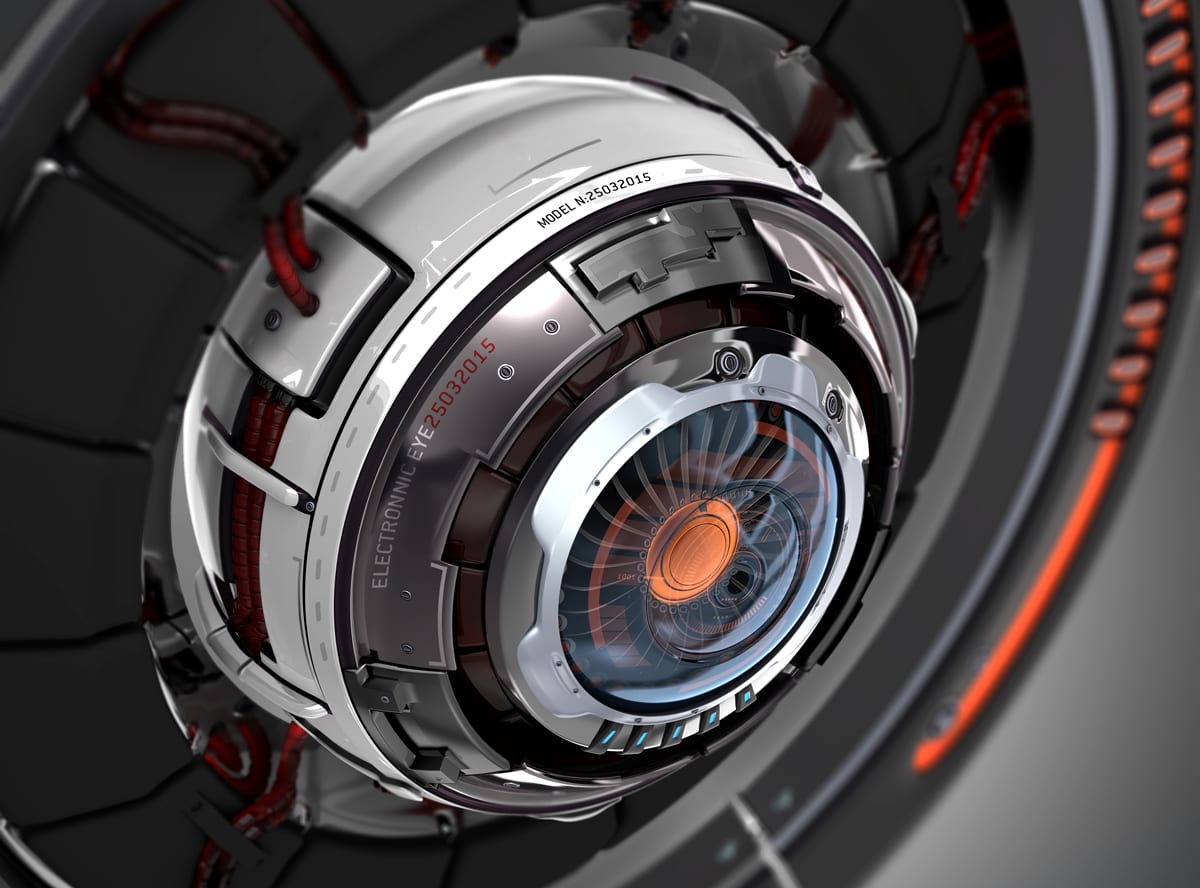The Coming Revolution in Enhanced Imaging and AI Will Change the World
Everybody wants to know the next big tech play. To invest before it goes mainstream.
Today I’m going to share a technology you probably haven’t really thought much about, but that will grow to a $19 billion industry in just five years.
The technology is known as Hyper Imaging, and it’s about to change your life in ways that are hard to imagine.
Sight is our most important sense, but our senses are very limited.
Humans see only a fraction of the actual light spectrum around us … and what we don’t see can hurt us.
Take the most obvious example; driving a car.
I live in a mountainous region in British Columbia, and frequently have to drive through horrible blizzards and fog between my home town and Vancouver.
At times I’m literally driving blind, able to see only a few meters in front of the car. I clench my teeth, squint like Clint Eastwood, and hope I’m not driving off a cliff.
On those trips I’ve often wished there were some way to simply peer through the fog, just as combat troops use night vision goggles to see in the dark.
Well, that time is already here. New ‘hyper imaging’ technology has been developed that will literally allow drivers to see through the fog, the snow, or at night. Combined with Artificial Intelligence in the vehicle, hyper imaging will even warn of upcoming threats, like a deer on the road beyond your vision.
But it’s not limited to driving. The dream of enhancing human vision has become a new and dynamic industry that is about to radically change the world as we know it, and will become a major driver of new wealth.
Hyper Imaging is one of the five top technologies being developed at IBM Research Frontiers Institute, along with its dozens of research partners. IBM is now predicting that in five years human beings will acquire “super hero vision’.
“In five years emerging portable imaging devices will help us see beyond the domain of visible light to reveal valuable insights or potential dangers that would otherwise be unknown or hidden from view,” says researcher Alberto Valdes-Garcia. “Our ability to “see” beyond visible light will reveal new insights that help us understand the world around us.
“This technology will be widely available throughout our daily lives, giving us the ability to perceive or see through objects and opaque environmental conditions anytime, anywhere.”
In other words, IBM expects humans will either wear or carry devices that allow them to see through walls, clothing, through fog and snow, or even analyze complex chemicals in the terrain around them.
Eventually, such devices could be embedded into the human brain through neural nets. Enhanced humans with these devices could land a jet in the fog, see a person hiding in a building through the walls, or even see a deer on the road around a sharp corner.
SUPER HERO VISION ALREADY A REALITY
Just about everyone is familiar with Superman’s admittedly creepy ability to see through solid objects like walls or … ahem … Lois Lane’s dress.
That ability was long considered pure science fiction. No one really expected people would be able to see through walls and clothing, and certainly not without the aid of a massive machine.
Now they can. Back in 2009 a huge controversy erupted over the installation of full-body scan devices that could see through people’s clothing and show their actual skin, as well as anything hidden.
In other words, like Superman, TSA agents could see you naked. They could also see any hidden devices you might have under your clothing.
Now, I’d rather do the Full Monty on a body scanner than have a TSA agent’s hands down my trousers, so I didn’t much care. I picked the scanner every time.
But a lot of people did care, including women who believed they were singled out for repeated screening for the entertainment of male security officers.
Since then a more refined version of the scanner has been released that doesn’t show the nude person under the clothes, but rather the human outline and any hidden objects.
But far more sophisticated devices are being developed all the time.
BIG BROTHER REALLY IS WATCHING YOU
Back in 2011 MIT’s Lincoln Lab developed a new radar technology that can ‘see’ through solid walls and watch people moving inside. At the time, the technology was pretty large and clunky and would have to be carried on a good sized truck. The idea was mainly to help SWAT teams spot suspects inside a building.
One year later that same technology shrunk to the size of a handheld device, the Range-R. USA Today reported in 2015 that at least 50 US law enforcement agencies, including the FBI, secretly equipped officers with the Range-R, and used them to peer into people’s homes without a warrant.
Devices like these are just the beginning.
The technologies now being developed and released over the next five years truly boggle the mind in their capability, especially when combined with Artificial Intelligence programs.
SEE LIKE A SHRIMP
Strangely enough, some animals already possess this type of enhanced vision.
The humble shrimp has a compound eye which allows it to see a wider spectrum of light than humans, right into the infrared.
Shrimp can literally see in the dark, and spot prey that would be invisible to humans.
But Hyper Spectral Imaging is now coming to humankind, with abilities that would turn a shrimp green with envy.
The promise of Hyper Imaging is huge. It will prevent deaths and injuries from car and plane crashes. It will help the police and combat troops avoid a deadly ambush. It will help farmers avoid crop failures, and food processors detect potential contaminants. Doctors will be able to literally see and then treat potentially life threatening disease, long before they become dangerous.
The problem with Hyper Imaging up to now has been cost, size and complexity.
The systems were so expensive that only large commercial operations can afford them. Hyper Imaging systems were also very large; for example, the security scanners at airports.
And finally, making sense of the image still requires high trained people to interpret the data.
And that’s where the work of the IBM team comes in.
In the words of Valdes-Garcia, “We are building a portable hyperimaging platform that “sees” across separate portions of the electromagnetic spectrum in one platform to potentially enable a host of practical and affordable devices and applications that are part of our everyday experiences.”
In other words, hyper imaging devices that are small, inexpensive, and easy to use.
THE ROLE OF AI and Augmented Reality
The tech being developed at IBM and elsewhere will combine a bundle of high performance and very compact sensors into a single platform. The sensors use a silicon computer chip and the array of antennas to form and electronically steer a beam of milliimeter wave energy to precisely capture data about any object, even if it’s completely obscured by fog or darkness.
The AI computer connected to the array can then analyze the data in milliseconds, and deliver the relevant results to the user.
For example, the system could tell you instantly if an object on the road in front of you is a tipped over garbage can or a deer, and you can act accordingly.
The other technology merging with Hyper Imaging is Augmented Reality.
Today, augmented reality generally is adding digital images to the reality around you through a smart phone or AR goggles. The game Pokemon Go is a good example.
But, when combined with Hyper Imaging and smart AI, these Augmented Reality systems would let humans actually develop that super hero vision IBM is predicting.
Security guards could literally spot a known terrorist or criminal in a crowd of people, even when they’re not actively looking for them.
A farmer could spot frost pockets on his or her land in winter, and take steps to save the crop.
Prospectors would be able to ‘see’ the images of minerals below their feet, and analyze that image instantly to see where best to sink a drill sample.
THE EXPLODING MARKET FOR HYPER IMAGING
All of this sounds interesting, but how sound is Hyper Imaging as an investment?
Like many types of tech linked to AI, it is on the cusp of an explosion in share value.
A study by Variant Market Research shows the market for Hyper Imaging will grow by 8.4 per cent a year to $18.9 Billion by 2024.
And that estimate does not take into account the potential that Hyper Imaging will become portable enough and cheap enough to be used by individuals.
Right now the technology is mainly used by the military and police, for medical diagnostics, by farmers and food processors, by mining prospectors or operators, and for astronomy.
But a portable system that could be embedded into cars, small consumer drones, smartphones or even into a ‘Google Glass’ type of device would move Hyper Imaging from the realm of industrial application into the mainstream.
Think that sounds unlikely?
It’s already happening.
The market leader in thermal imaging FLIR has just released a Forward Looking InfraRed device that clicks into your smartphone, for only $279 Cdn. (flir.ca)
FLIR ONE lets you not only see in the dark, but can allow anyone to check the insulation in their house for heat loss, or check for overloaded circuits that could cause a fire. You can trace heating ducts or even spot a leaky water pipe behind solid walls.
FLIR also makes a device called the PathFindIR that mounts on the front of your car, and allows you to see objects on the road ahead in fog or total darkness.
This amazing device also connects to a relatively simple AI program that identifies animals and pedestrians and warns you about them instantly.
The awesome new company Navdy (navdy.com) shows how this tech can be incorporated into cars of the future, with an amazing heads up display (HUD) that puts important information on the windshield of your car, while letting you control your smartphone with a simple gesture.
Combined with the FLIR, the Navdy would give you real time imaging of anything on the road in front of you, no matter how bad the visibility might be.
THE FIVE YEAR WINDOW
The miniaturization and commercialization of these Hyper Imaging devices will transform key companies, like FLIR, from primarily manufacturers of large industrial applications, to producers of small devices that are used by everyone, all the time.
And those are the companies you’re looking for.
Interested in doing more research on your own?
In addition to the work being done by IBM and FLIR, some of the top companies in the space include Telops, Applied Spectral Imaging, Corning Incorporated, Surface Optics, and Resonon.
Apple and Google are also expected to be big players in the space as they roll out their AR and AI research into real products.
In our portfolio, Nexoptic Technology Corp. (TSX-V: NXO) (OTC: NXOPF), which we’ve covered here before, also comes into play. Their Blade Optics lens allows you to see a much greater distance with an exponentially shorter lens, and could become a major player in any optics related industry.
Disclosure: We’re biased towards NexOptic because the Company is an advertiser and we currently own shares NexOptic.












